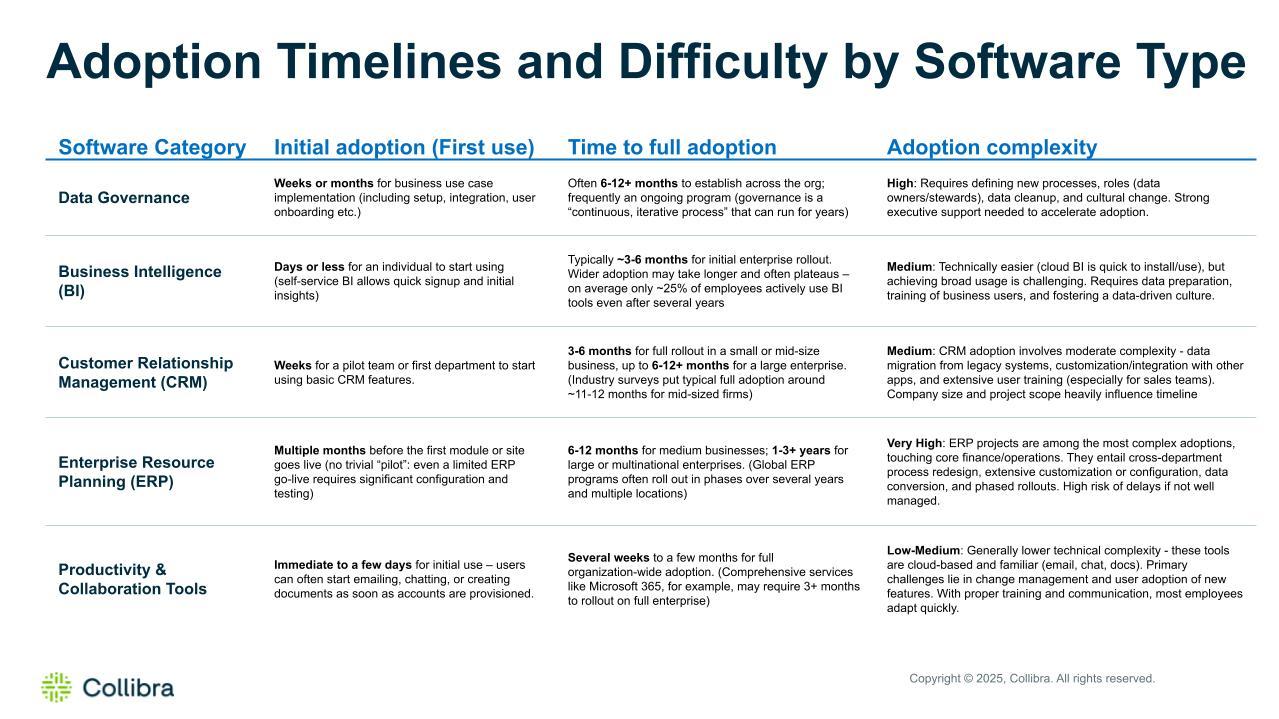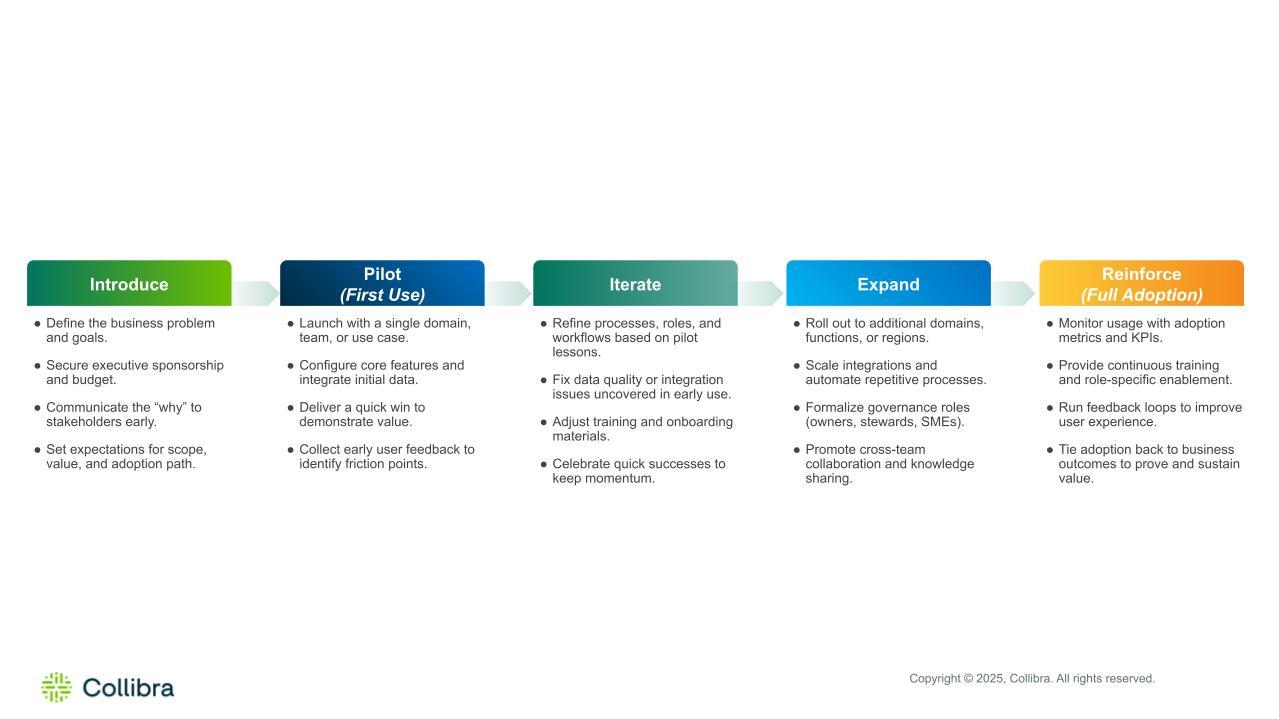From pilot to payoff: Why successful data governance takes time

Adopting enterprise software – from initial introduction to full organizational rollout – is a complex, multi-phase process. It includes technical deployment, user training, data migration and change management. Data governance platforms in particular are often seen as difficult to adopt. But is that perception fair? And how does data governance adoption compare to other categories of enterprise software?
In this article, we will explore the typical adoption path for data governance platforms. Why does it take time to reach full organizational use? What makes adoption challenging? And how can you overcome common obstacles?
Importantly, we’ll distinguish between the two milestones: time to first use (initial introduction/pilot use) and the time to full adoption (organization-wide rollout and routine usage).
Ready for data governance. See how Collibra can help.
Adoption timelines vary
The reality is that software adoption is never one-size-fits-all.
Productivity suites like MS 365 can be introduced in days, while ERP or governance platforms often stretch into multi-year programs. The difference lies in scope: some tools fit neatly into daily work with minimal disruption, while others require deep process changes.
The stakes are high. Failed CRM adoption can mean lost revenue; failed governance adoption can expose companies to compliance breaches and multimillion-dollar fines.

Data governance: Description and scope
Data governance platforms help organizations catalog data assets, assign responsibilities, define data policies, establish data lifecycle processes and manage data quality. Unlike most enterprise tools, governance is inseparable from people and processes, and adoption means establishing governance committees, roles (data stewards, owners), and workflows for managing data. Success isn’t measured just by software installation, but by embedding governance into daily data practices. And as we all know, people love changes in their daily activities. Spoiler alert: no, they don’t.
Time to first use can be fast
Technically, deployment can be quick. Days, in some cases. But meaningful use requires integrations and population of the data catalog, which usually takes weeks or months.
For example, one financial firm integrated ERP data into Collibra’s Data Catalog within about three months, with a single specialist working full-time. Larger teams can accelerate this and show value within weeks.
But full adoption takes time
Reaching full organizational adoption of data governance is typically a long-term effort. Anyone working with data governance has heard this hundreds of times - ‘it’s a marathon, not a sprint’ and should be treated as an ongoing program rather than a one-off project. In practice, it can take 6–12 months or more to roll out governance frameworks across all business units.
But the rollout is just the beginning; afterwards, scaling with new data assets, policies, and users can take even more time.
Based on my 15 years of experience building data governance programs, I can say that the most effective approach is incremental. This means implementing a business use case in phases — starting with a single data domain or a subset of assets to show value quickly, then gradually expanding the scope
It’s worth mentioning that full adoption of a data governance platform is not about every employee using a tool but more about embedding governance practices into your organization’s culture and workflows.
Why adoption is difficult
The adoption of data governance tools is challenging because they imply changes in how people handle data. Key obstacles include:
- Organizing governance committees
- Cleaning and migrating large volumes of data
- Overcoming cultural resistance
In other words, the size of the organization and data landscape, the complexity and quality of existing data and the level of executive sponsorship may significantly influence the speed of adoption.
Organizations with strong leadership support and clear communication of benefits — improved compliance, faster analytics, reduced risk — see adoption grow faster. Without leadership buy-in and user engagement, governance programs may go live but fail to deliver visible value and often collapse.
Comparing adoption across enterprise software
We’ve looked at why adoption can be more difficult for data governance. To put this into perspective, let’s compare data governance with other categories of enterprise software on three dimensions: time to first use, time to full adoption and adoption difficulty.
The table below is an overview of the timelines and challenges, with commentary on what makes each category unique.

From rollout to results
Successful adoption of enterprise software always follows a pattern, and data governance is no different. It’s a journey in stages, and the more you progress, the more momentum your organization builds.

As the graphic above shows, adoption follows a pattern of:
- Introduce: Define the business problem, secure executive sponsorship and set clear expectations for scope, value and adoption.
- Pilot (First use): Launch with a single domain or team. Configure core features, deliver a quick win and collect feedback to uncover friction points.
- Iterate: Refine processes, roles and workflows. Fix data quality issues, adjust training and celebrate early successes to keep momentum.
- Expand: Roll out to additional domains, functions or regions. Formalize roles for owners and stewards, and scale integrations to drive efficiency.
- Reinforce (Full adoption): Monitor adoption metrics, provide continuous training, and tie governance practices back to business outcomes to prove and sustain value.
For data governance, this progression takes time—often months or years—but the payoff is lasting.
It’s also important to remember that Full adoption isn’t about every employee using the platform. It’s about embedding governance into the culture so that trusted data becomes the default for every decision, every model and every initiative.
Adoption done right transforms governance from a cost center into a driver of measurable business value. It accelerates analytics, reduces risk and builds the foundation for Data Confidence™ across your entire organization.
Learn more about Data Confidence and Collibra Data Governance today.
Keep up with the latest from Collibra
I would like to get updates about the latest Collibra content, events and more.
Thanks for signing up
You'll begin receiving educational materials and invitations to network with our community soon.
